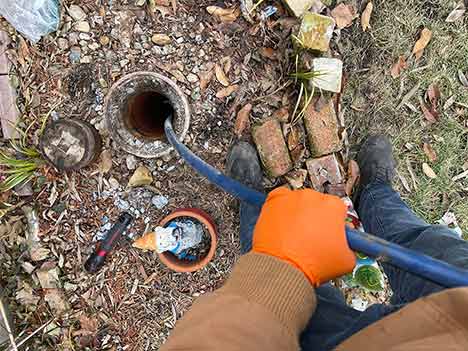
Sewer line clogging is a huge problem that can create major issues in your plumbing system, from slow drains to bad odors or even a sewer backup. If the debris inside a sewer line is not quickly removed, it can eventually cause the line to leak or become blocked completely, asserts Whole Property Management.
What causes sewer line blockage, and what are the best solutions for the problem?
Causes of sewer line blockage
As long as there is debris inside the water that enters a sewer line, there is a chance that the line will clog and ultimately block. That is because debris will be deposited inside the pipes, impeding water flow and causing even more debris to remain inside the line.
This process will continue until enough debris has built inside the pipes to stop the water flow. When this happens, the blockage will cause various drain problems inside the home. Factors that promote sewer line blockage include:
- Flushing fats, oil and grease (FOG) into the drain
- Dumping starchy foods, stringy vegetables, coffee grinds, eggshells, etc. into the drain
- Flushing things other than toilet paper and human waste into the toilet
- Soap scum and mineral scale buildup within the pipes as a result of hard water
- Tree roots intrusion into the sewer line
- Ground movements that result in the formation of low points along the sewer line
The best ways to clear a blocked sewer line
The best way to deal with a blocked sewer line is to have the line cleaned professionally.
Although it is possible to clear a blocked drain using home remedies, these methods only work for clogs and blockages near the drain opening. If the problem is deep inside the sewer system, it is often not possible to fix it with DIY methods like:
- Pouring a baking soda and vinegar mix into the drain
- Melting the clog with a solution of salt and hot water
- Using a plunger to release a clogged toilet or sink
- Snagging the debris with a handheld drain snake or clothes hangar
Most times, these methods do not remove the debris inside the pipes; they push it further down the line. To clear a blocked drain with minimal risk of the problem coming back shortly, here are the best methods to use:
Mechanical/motorized drain snake
This traditional method is still widely used because of its effectiveness. Mechanical drain snaking is also known as a sewer rodding service. It uses a mechanical auger or cutting head attached to a flexible metal cable to remove blockages from a sewer line.
The metal cable, with the attached cutting head, is inserted into the sewer line via a floor drain or cleanout. It is then pushed through the line until it reaches the site of the blockage. The spinning head at the end of the cable is used to cut through or snag the debris. This method is effective for removing blockages caused by hair, food fiber or soft materials.
Drain snakes can also be motorized instead of manually operated. Motorized drain snakes can deal with the worst kind of sewer line blockages, including tree roots and sludge removal. Motorized drains snakes can travel further into the sewer line. All drain snakes usually come with a set of cutting heads for different clogs.

Hydro-jetting has the added advantage of scouring the walls of the sewer pipes and washing the dislodged debris from the sewer line. That makes hydro-jetting a perfect method for preventing buildup inside a sewer line.
Hydro-jetting
Hydro-jetting is a modern method for clearing blocked sewer lines. It uses water as its primary agent for unclogging blocked drains. To clear a clogged sewer line, high-pressure water is sent into the line using a special machine called a “jetter.”
The typical hydro-jetting equipment consists of a water tank, a jetter to supply the required pressure, a flexible high-pressure water hose and a specialized stainless steel nozzle.
The hose is inserted into the sewer line with the nozzle at one end. Water is sprayed into the line at pressures between 4,000 and 5,500 psi. The water pressure used in a hydro-jetting service is enough to remove tree roots, scale and other stubborn materials from the pipes.
Hydro-jetting has the added advantage of scouring the walls of the sewer pipes and washing the dislodged debris from the sewer line. That makes hydro-jetting a perfect method for preventing buildup inside a sewer line.
Sewer camera inspection
Sewer camera is not a drain-cleaning method but a step which must be taken to ensure the effectiveness of the two drain-cleaning methods discussed above. Sewer camera inspection should be done before attempting to clear a blocked sewer line.
The inspection allows for a close-up visual inspection of the sewer line. That makes it possible to locate the blockage and determine the best method for dealing with the problem. Sewer camera inspection helps you save time and money.
Conclusion
Finally, which of these two methods is the right for solving your home’s sewer line problems? It depends on the nature of the blockage. To find out what is blocking your sewer line and the best way to remove it, talk to a professional drain cleaning company.
